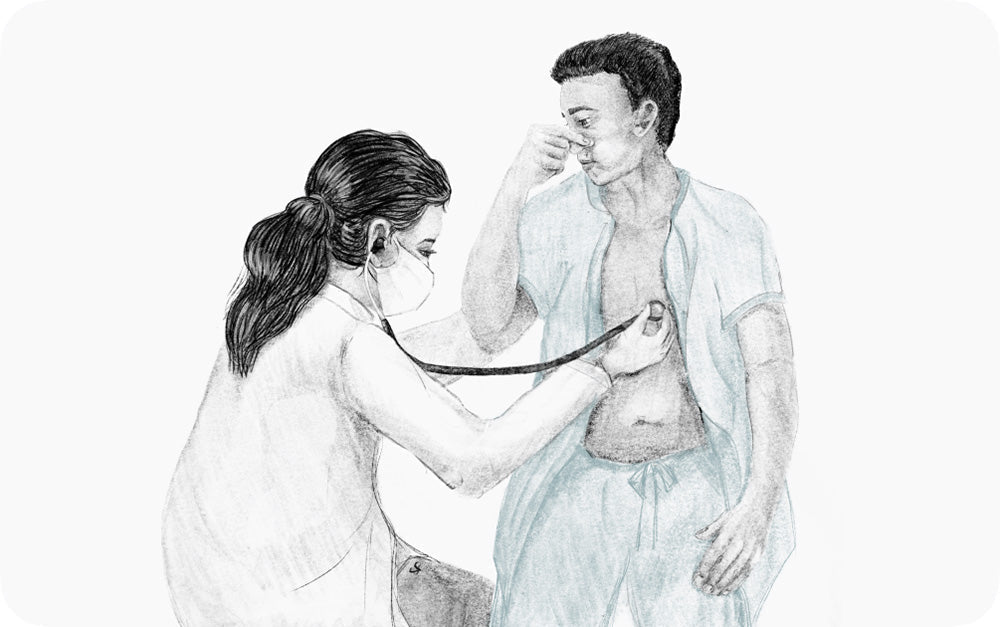Dynamic Auscultation Maneuvers for Murmur Detection
Dynamic auscultation maneuvers help diagnose structural murmurs. Explore 6 maneuvers that will improve your murmur detection confidence.

Overview of maneuvers for murmur detection
Dynamic cardiac maneuvers are a set of actions that cause blood to flow faster or slower through different parts of the heart. The change in blood flow alters the volume or intensity of structural murmurs, making them easier to identify and differentiate. Each maneuver alters blood flow by adjusting cardiac preload or afterload. Preload refers to the amount of blood in each ventricle before the start of systole.4 Afterload is the resistance the heart must overcome to eject blood into the body. Dynamic cardiac maneuvers are useful tools that can effectively narrow down potential diagnoses when attempting to identify specific murmurs.

Respiration: Inspiration
During inspiration, right-sided murmurs such as tricuspid regurgitation and pulmonary stenosis are more audible due to increased venous return to the right ventricle. The increased venous return is caused by a more negative intrathoracic pressure created by taking a deep breath. This leads to increased blood flow through the diseased valve, which enhances the sound of the murmur.1, 2, 3

Respiration: Expiration
Left-sided murmurs such as mitral regurgitation and aortic stenosis become louder during expiration. During expiration, collapsing lung tissue causes an increased volume of blood to rush through the mitral valve. This increased blood flow highlights any structural issues impacting the left side of the heart.1, 2, 3

Valsalva Maneuver
To perform the valsalva maneuver, auscultate the patient’s chest and instruct the patient to close their mouth, pinch their nose, and exhale forcefully. This maneuver reduces preload - causing less venous blood to return to the right side of the heart during the cardiac cycle. Most murmurs decrease in intensity during the valsalva maneuver. Two exceptions are the systolic murmurs of hypertrophic obstructive cardiomyopathy, which becomes louder, and mitral valve prolapse, which becomes longer and often louder.1, 2, 3

Squat to Stand Maneuver
While auscultating the chest, instruct a young or athletic patient to perform a squat, hold for a few seconds, and then stand up abruptly. The squat-to-stand maneuver reduces preload — causing less venous blood to fill the ventricles before systole. Sudden standing will make murmurs due to hypertrophic obstructive cardiomyopathy and mitral valve prolapse sound louder. Other murmurs (AS, MS, AR, MR, VSD, etc.) will sound softer.1, 2, 3


Stand to Squat Maneuver
Instruct a young or athletic patient to stand upright, begin auscultating their chest, and then have the patient bend down into a deep squat for 30 seconds. The squatting motion will force blood that was stored in the legs back up into the heart, causing increased preload as the heart receives a larger volume of blood to the left ventricle. Most murmurs become louder while squatting. In contrast, a murmur due to hypertrophic obstructive cardiomyopathy will sound softer.1, 2, 3


Isometric Handgrip
Instruct the patient to sit up straight, raise their arms, and forcefully clench their fist or tightly grasp an item (washcloth, metal rod, etc.) for 30 seconds while you auscultate their chest. This maneuver will increase afterload - intensifying vascular resistance and forcing the heart to work harder to pump blood out. The isometric handgrip will increase the intensity of ventricular septal defect, aortic/mitral regurgitation murmurs; and decrease the intensity of murmurs caused by hypertrophic obstructive cardiomyopathy and mitral valve prolapse. This maneuver is most useful in distinguishing between an aortic stenosis murmur and a aortic/mitral regurgitation murmur. An aortic stenosis murmur will remain unchanged, whereas a mitral regurgitation murmur will sound much louder.1,2,3

References
2. Dynamic Auscultation Topic Review. www.healio.com. March 22, 2023.
3. Thomas SL, Makaryus AN. Physiology, Cardiovascular Murmurs. Nih.gov. Published June 3, 2019.
4. Heart Preload - an overview | ScienceDirect Topics.
Medical Advice Disclaimer
DISCLAIMER: THE CONTENT SET FORTH HEREIN DOES NOT PROVIDE MEDICAL ADVICE NOR IS AN ATTEMPT TO PRACTICE MEDICINE
The information, including but not limited to, text, graphics, images, and other material contained on this website are for informational purposes only. No material on this website or document are intended to be a substitute for professional medical education, advice, diagnosis, or treatment.
MKT-0002637 Rev 1.0
